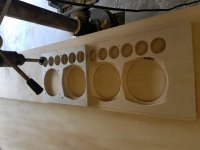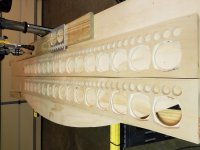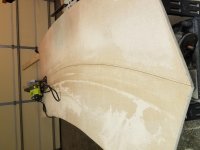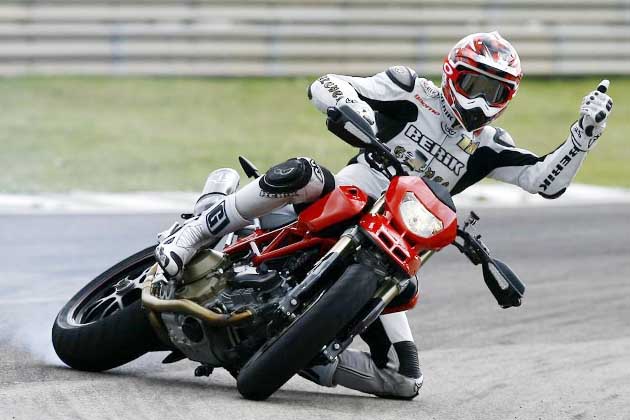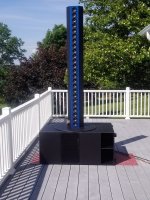Lots of holes. Glad to have this part done!
If I decide I like these and want to make 9 more to complete a theater bed layer... dang.
- edit: just noticed that pic makes it look like my row of holes is a bit wobbly. It isn't, just an illusion of the pic. I marked straight guidelines the width of the template apart down the panel to make sure I stayed globally straight.
If I decide I like these and want to make 9 more to complete a theater bed layer... dang.
- edit: just noticed that pic makes it look like my row of holes is a bit wobbly. It isn't, just an illusion of the pic. I marked straight guidelines the width of the template apart down the panel to make sure I stayed globally straight.
Attachments
Last edited:
These will use peerless OX20SC00-04 3/4" fabric dome tweeters, and the Dayton ND105-8 4" midbass.
The Dayton is the slightly larger version of the driver used in Keele's PE CBT36 kit.
I have used the SB65 a few times in other projects and love them, but wanted more displacement capability as these may serve double duty for music and theater. Even though I'm using 2 less midbass per array than the CBT36, there is still a decent bump in total displacement. Probably more significant if you account for the shading used.
The Dayton is the slightly larger version of the driver used in Keele's PE CBT36 kit.
I have used the SB65 a few times in other projects and love them, but wanted more displacement capability as these may serve double duty for music and theater. Even though I'm using 2 less midbass per array than the CBT36, there is still a decent bump in total displacement. Probably more significant if you account for the shading used.
These will use peerless OX20SC00-04 3/4" fabric dome tweeters, and the Dayton ND105-8 4" midbass.
Cool! I too am looking forward to the mounting!
Been a while, I've have had a bit of time to let some impressions settle, on how the 24 TC9 straight-line and CBT versions compare.
Most of my time has been spent on the straight-lines, as they were the ones meant for steering experiments.
Plus I found I had underestimated the amount of different tuning necessary for each setting, room corners vs pulled out, and versus outdoors.
Made numerous attempts in each setting, trying to make good sense of how the array interacts with the room.
Anyway, when pulled out into the room a bit, or outdoors, the straight-lines sound great. But I can't say I've ever really been pleased with them in room corners. Could simply be the room i want them in, with its corner and ceiling irregularities....and probably also an unwillingness to heavily treat the room corners.
Ended up crossing them at 100Hz, for use with the dual 18" PPSL sub shown.
Steering has worked well for 6 sections of 4 drivers each.
It's very easy to use amplitude shading and delays to the sound to the top of the array...which is nice outdoors. I'd call the steering experiments a success, but I don't know if I would bother with steering now that experiments are done. Maybe the only 'steering' exception I'd like to continue playing with, is the frequency shading, using the center of the array full range, and progressively low passing towards the ends.
Mimicking the CBT's curvature and shading also worked, but doesn't sound quite as continuous as the CBT when listening at various heights. Close, but no cigar.
I think the continuous curve of 24 drivers vs having 6 sections curvature is an issue, but not one I'm willing to investigate further.
The CBT's appear to be really room-position friendly!
I've been a little amazed at how well tunings at one spot have held up for other spots.
Tuning has been plain easy compared to the straight-line. (I think Wesayso hinted as much
Looking forward to listening to the CBT's outdoors and integrating the subs, (which is something I've never had any luck doing indoors.)
I do believe my arrays have found their identity as CBTs, ...indoors for sure. Hoping outdoors pans out too.
Most of my time has been spent on the straight-lines, as they were the ones meant for steering experiments.
Plus I found I had underestimated the amount of different tuning necessary for each setting, room corners vs pulled out, and versus outdoors.
Made numerous attempts in each setting, trying to make good sense of how the array interacts with the room.
Anyway, when pulled out into the room a bit, or outdoors, the straight-lines sound great. But I can't say I've ever really been pleased with them in room corners. Could simply be the room i want them in, with its corner and ceiling irregularities....and probably also an unwillingness to heavily treat the room corners.
Ended up crossing them at 100Hz, for use with the dual 18" PPSL sub shown.
Steering has worked well for 6 sections of 4 drivers each.
It's very easy to use amplitude shading and delays to the sound to the top of the array...which is nice outdoors. I'd call the steering experiments a success, but I don't know if I would bother with steering now that experiments are done. Maybe the only 'steering' exception I'd like to continue playing with, is the frequency shading, using the center of the array full range, and progressively low passing towards the ends.
Mimicking the CBT's curvature and shading also worked, but doesn't sound quite as continuous as the CBT when listening at various heights. Close, but no cigar.
I think the continuous curve of 24 drivers vs having 6 sections curvature is an issue, but not one I'm willing to investigate further.
The CBT's appear to be really room-position friendly!
I've been a little amazed at how well tunings at one spot have held up for other spots.
Tuning has been plain easy compared to the straight-line. (I think Wesayso hinted as much
Looking forward to listening to the CBT's outdoors and integrating the subs, (which is something I've never had any luck doing indoors.)
I do believe my arrays have found their identity as CBTs, ...indoors for sure. Hoping outdoors pans out too.
Attachments
Been a while, I've have had a bit of time to let some impressions settle, on how the 24 TC9 straight-line and CBT versions compare. ...
Thanks for sharing.
Hi Mark:
Your experience with corner vs out in room is consistent with mine. When I pull the array out in the room its cleaner pre-treatment but treating is difficult because the frequencies are lower. For the array in the corner, relatively thin treatment suffices and its clear exactly where to put it.
Out in the room, I just had a single boundary null which I could happily treat for a single position and declare victory. Chances are with 2 speakers plus subs running it wouldn't be very noticeable. But my living room unlike my garage isn't big enough for that.
As to CBT vs straight, I did a fairly complete CBT design before deciding to go straight. I expected the CBT out in the room to be fairly forgiving (so long as it was toed in) but I also expected simple treatments to suffice for tight to the wall placement of a straight array and I wanted more and unweighted drivers for the bass extension. So I paid my money and took my chance on the straight array, not wanting to do both, even in the interest of science
I love your woofers, its clear these arrays need their support, especially mine with their smaller drivers and your CBTs due to weighting.
Looks like both approaches are winners
Your experience with corner vs out in room is consistent with mine. When I pull the array out in the room its cleaner pre-treatment but treating is difficult because the frequencies are lower. For the array in the corner, relatively thin treatment suffices and its clear exactly where to put it.
Out in the room, I just had a single boundary null which I could happily treat for a single position and declare victory. Chances are with 2 speakers plus subs running it wouldn't be very noticeable. But my living room unlike my garage isn't big enough for that.
As to CBT vs straight, I did a fairly complete CBT design before deciding to go straight. I expected the CBT out in the room to be fairly forgiving (so long as it was toed in) but I also expected simple treatments to suffice for tight to the wall placement of a straight array and I wanted more and unweighted drivers for the bass extension. So I paid my money and took my chance on the straight array, not wanting to do both, even in the interest of science
I love your woofers, its clear these arrays need their support, especially mine with their smaller drivers and your CBTs due to weighting.
Looks like both approaches are winners
Last edited:
speaking of CBT, Keele et.al. just published a new paper on CBT theory in AES Journal showing other things that Legendre shading is good but not optimal, what the optimal shading is and including theory for discrete CBT
Found a free/public link for the article
http://faculty.tru.ca/rtaylor/publications/cbt_monopole.pdf
Found a free/public link for the article
http://faculty.tru.ca/rtaylor/publications/cbt_monopole.pdf
The Richard Taylor and Don Keele paper referenced was presented at the October 2017 AES Convention. Taylor's work puts CBT theory on a firmer mathematical foundation. In this paper he offers two new shading functions--one a simple cosine shading which has the widest beam pattern and the other shading based upon Chebyshev polynomials which yields a better controlled frequency response. Perhaps in the future we will be able to employ shading improvements for more optimum CBT performance.
Taylor also points out that there is no essential difference between the near and far field behaviors of CBTs. Keele has previously stating this nature but now mathematics solidifies that assumption.
Taylor also points out that there is no essential difference between the near and far field behaviors of CBTs. Keele has previously stating this nature but now mathematics solidifies that assumption.
Last edited:
Hi Mark:
Your experience with corner vs out in room is consistent with mine. When I pull the array out in the room its cleaner pre-treatment but treating is difficult because the frequencies are lower. For the array in the corner, relatively thin treatment suffices and its clear exactly where to put it.
Out in the room, I just had a single boundary null which I could happily treat for a single position and declare victory. Chances are with 2 speakers plus subs running it wouldn't be very noticeable. But my living room unlike my garage isn't big enough for that.
As to CBT vs straight, I did a fairly complete CBT design before deciding to go straight. I expected the CBT out in the room to be fairly forgiving (so long as it was toed in) but I also expected simple treatments to suffice for tight to the wall placement of a straight array and I wanted more and unweighted drivers for the bass extension. So I paid my money and took my chance on the straight array, not wanting to do both, even in the interest of science
I love your woofers, its clear these arrays need their support, especially mine with their smaller drivers and your CBTs due to weighting.
Looks like both approaches are winners
Hi Jack, sorry for the slow reply. I'm at Infocomm, and like a kid in a candy store
I think I get exactly where you are coming from on the straight vs CBT decision. I really wanted the straight in-corner to work bes,t simply for room ergonomics. And it still might if the room wasn't so problematic.....
I found toe-in on the CBT's to really help...almost looks like a pair of giant bug antennas haha.
Was toe-in working well, something you saw in modeling.
Thanks to you and Jim for the new Keele paper. I wish I knew how to try the wide and narrow shading coefficients.
But the math is over my head...maybe a chart/spreadsheet for generating the shading will pop up sometime soon.... I'll certainly try it.
Just read though this entire thread. Epic work everyone. Thank you so much for posting all this.
About to build a pair of Murphy Corner Line Arrays. Right now debating whether to run all 24 drivers per side on one amp, or break them up over a 12ch amp. Something is telling me 4 drivers per amp ch would be an easier load.
I noticed all the posts stopped almost a year back. Any updates?
About to build a pair of Murphy Corner Line Arrays. Right now debating whether to run all 24 drivers per side on one amp, or break them up over a 12ch amp. Something is telling me 4 drivers per amp ch would be an easier load.
I noticed all the posts stopped almost a year back. Any updates?
- Status
- This old topic is closed. If you want to reopen this topic, contact a moderator using the "Report Post" button.
- Home
- Loudspeakers
- Full Range
- Line array steering ?
